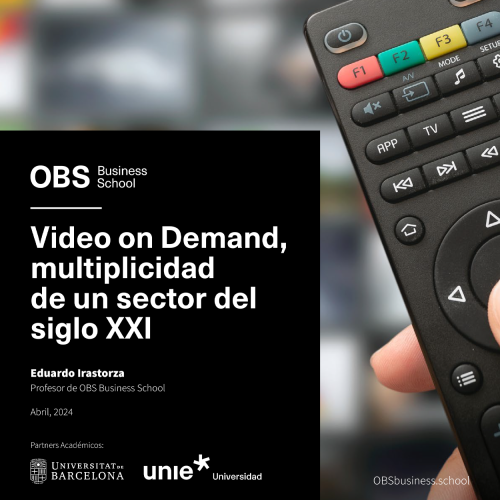
OBS Report: Video on Demand, the multiplicity of a 21st century industry
The video-on-demand industry is now worth over $100 billion
- More than a billion VOD subscribers are expected in the next few years, although it will be mainly brands that will sustain them.
- A report by OBS advances the enormous possibilities of video on demand 3.0: interacting in real time with our favourite series to condition the script or to buy the main character's clothes or the car he or she drives. The user will cease to be a spectator and become the protagonist. We will be able to consume VOD by looking at the door-screen of our fridge, in the smart mirror of our bathroom, on the back of the seat of our cars, even on the AI glasses of our next flight.
- VOD will become a vital reference for audiences and a meeting point, developing its social and socialising dimension.
April 2024. OBS Business School publishes the report Video on Demand, multiplicity of a 21st century sector, written by Professor Eduardo Irastorza. In it, he analyses the reality of a sector that is going from being dominated by a few international players to being dominated by multiple players, both in the production and consumption of content. The so-called BRICS countries (Brazil, Russia, India, China, India and South Africa) are gaining strength, and they are doing so at great speed.
Although it is a very young sector, the speed at which it is changing is hardly comparable to any other area of culture or the economy. In fact, VOD is set to become a vital reference point for audiences and a meeting point, developing its social and socialising dimension. In the first phase, it was limited to providing a wide range of content in exchange for a subscription. In the second phase, it went from "I sell what I have, to I have what sells". Platforms began to "listen" to users, to identify their preferences, even to segment them; at first in a fairly generic, almost socio-demographic way, and later on under attitudinal criteria thanks to the increasingly powerful Big Data tools. The third phase is the one that awaits us and in it the user will play a decisive role in establishing the "direction" he or she wants to give to the content, and may even determine the evolution of a script in real time. The new generations of digital natives, accustomed to making all the decisions at the moment of consuming content, will demand the same from VOD. Co-creation in the fullest sense will have arrived, even incorporating the user himself in the story. We will no longer be spectators but real protagonists and, although it may sound like science fiction, digital giants such as Meta are already working on it and the project is also part of the plans of Netflix, Amazon and Disney. In this sense, AI will become an essential ally.
Therefore, watching a series, a film or a documentary will be much more than just being exposed to a story. It will be an experience that opens up to travel, shop, learn, experience, experience and captivate with brands working together. The great director Steven Spildbberg, for example, is setting up a VOD content production company in which there will be series with just three-minute episodes that will be perfectly consumable on a mobile phone during a bus journey or in a waiting room. This means that, in these productions, both the scripts and the composition of the images will have their own structure and style. Consuming VOD will no longer be limited: we will be able to do it by looking at the screen-door of our fridge, at the smart mirror in our bathroom, at the back of our car seats, even at the AI glasses on our next flight. And very soon it will also be a powerful tool for training in a wide variety of disciplines; agreements and endorsements from educational institutions will be demanded by audiences to guarantee the rigour of the content, and we are not only talking about the university sphere, but also about sport, leisure and hobbies.
In view of these changes in the way VOD is consumed, the profitability of the sector, which today is sustained by a more or less personalised and sophisticated subscription model, will be based on the revenue generated by brands, which will pay to be present, because is there anything more impactful than being part of the chosen content during chapters and chapters in endless seasons? Is there anything more relevant than making the action happen in the tourist setting you offer? Is there a more attractive way to present a new fashion collection than in a luxury series? The user will be able to interact in real time with the products and, if they wish, purchase the clothes worn by the protagonist of a series, book a trip to the country and the hotel where they are staying, test drive the car they are driving or contact people with the same tastes as them, sitting next to them on a virtual sofa, in a parallel online conversation. These are just some of the possibilities opened up by VOD 3.0.
The VOD business
The primary aspiration of any VOD platform is to conquer the "frontline", i.e. to manage a direct and unmediated relationship with the user. The knowledge it has of the user will be its greatest business fund, its greatest strength and the key to occupying a predominant position in the market. In fact, the biggest technology brands, such as Google, YouTube, Instagram or Alibaba are characterised by being particularly robust in the management of this factor. "In the future, there will only be two kinds of companies: on the one hand, those that have the frontline and, on the other hand, the more or less subjugated and long-suffering suppliers, always replaceable, always under threat. In this sense, the VOD sector has every chance of occupying a privileged position in the future of commerce," says Eduardo Irastorza, professor at OBS Business School.
The future will be characterised by multi-productions, which will not only involve platforms, studios, production companies and TV channels, but also multinationals, advertisers, institutions, nations, sports clubs and even global influencers. This will require the involvement of the best programming engineers, Big Data management, CRM and AI software. The inspired director and scriptwriter will remain critical, but success will depend on the perfect understanding of the production and marketing teams.
The VOD Industry in figures
The sector's revenues this year are expected to reach 108.5 billion dollars globally. At the top of the list is the United States (80.3 billion dollars), which doubles the figures of the second-placed China (32.08 billion dollars), a country that feeds almost exclusively on its domestic market and is still a long way from consolidating its exports in this sector. They are followed by the United Kingdom (8,789 million dollars), Japan (7,206) and Germany (6,426). Growth is expected to be sustained over the next three years, reaching $137.7 billion in 2027.
The largest subscription shares are currently held by Netflix with 277 million, followed by Amazon Prime Video (265) and Disney (222). In the coming years, the number of subscriptions will continue to grow worldwide to around 1 billion and, barring mergers or unexpected surprises, the platforms that dominate the industry will be the same as they are today. Their revenue model, however, will go far beyond subscriptions and will be based on two new pillars: on the one hand, revenue from agreements with companies and their brands that want to appear as part of the content and, on the other, rights to their content used by third parties, such as showrooms, toys, games or theme parks, among others.
What about the contents?
Korean and Turkish romance series are already winning over audiences in Europe and America. So are Japanese fantasy and animation series, which inspire millions of fans all over the world. Latin American musicals entertain us day and night and the incredible "Bollywood" productions engage not only millions of Indians and the many Asian immigrant communities, but also Westerners themselves. In fact, its output already exceeds that of Hollywood and each year its quality increases and its themes become more exportable, without renouncing its recognisable aesthetics. And the enormous impact of South Korean productions will soon be surpassed by Indian ones. The best showcase for African culture is London's multi-racial Notting Hill Festival, and the best place to celebrate the Chinese New Year is San Francisco's China Town. All of this, of course, converted into content on the big VOD platforms. One only has to look at the enormous growth of Asian content on the major global platforms to confirm that we are already moving in a multicultural environment. Diversity of content will therefore be a powerful resource for attracting and engaging diverse cultural, demographic, lifestyle and faith communities. In them, users will recognise themselves and meet like-minded people. They will be both audience and protagonists of the content.
Content written by:
Carmen García-Trevijano
OBS Business School Press Office

